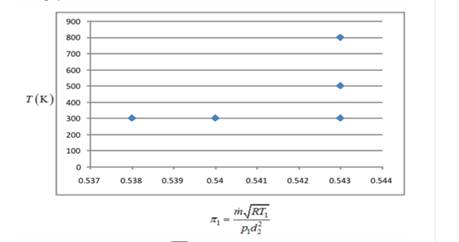
To rewrite:
This function in dimensionless form, using dimensional analysis.
Answer to Problem 5.2CP
The dimensionless function is
Explanation of Solution
Given Information:
For fluid exiting a nozzle which is a gas instead of water, upstream pressure p1is large and d2,the exit diameter is small. The difference
Ref Fig 3.49:

Concept Used:
The number of pi groups are to be calculated:
Where, k is the number of variables and r is the number of fundamental references.
On substituting 5 for k and 4 for r ,
Calculation:
Dimensional analysis is applied to find the pi groups.
Where
On substituting
On equating M coefficients:
On equating
On equating T coefficients:
On equating L coefficients:
Therefore, the following values are obtained:
Therefore, the pi group is as follows:
Hence, the pi group is:
Conclusion:
The dimensionless function is
To plot:
Data using the dimensionless form obtained, a curve fit formula and a single value of a range.
Answer to Problem 5.2CP
The data is plotted as above and the measured value of
Explanation of Solution
Given Information:
For fluid exiting a nozzle which is a gas instead of water, upstream pressure p1 is large and d2, the exit diameter is small. The difference
Ref Fig 3.49:

Diameter of pipe, d2 = 1 cm
The following values of mass flow through the nozzle are shown by the measurements for flow of air:

Concept Used:
The value of
| T( K) | |
| 300 | 0.543 |
| 300 | 0.54 |
| 300 | 0.538 |
| 500 | 0.543 |
| 800 | 0.543 |
Calculation:
The pi value is calculated by substituting 0.037 kg/s for
And
The values obtained are plotted on the graph as follows:

Hence, the measured value of
Conclusion:
The data is plotted as above and the measured value of
Want to see more full solutions like this?
Chapter 5 Solutions
FLUID MECHANICS-PHYSICAL ACCESS CODE
 Elements Of ElectromagneticsMechanical EngineeringISBN:9780190698614Author:Sadiku, Matthew N. O.Publisher:Oxford University Press
Elements Of ElectromagneticsMechanical EngineeringISBN:9780190698614Author:Sadiku, Matthew N. O.Publisher:Oxford University Press Mechanics of Materials (10th Edition)Mechanical EngineeringISBN:9780134319650Author:Russell C. HibbelerPublisher:PEARSON
Mechanics of Materials (10th Edition)Mechanical EngineeringISBN:9780134319650Author:Russell C. HibbelerPublisher:PEARSON Thermodynamics: An Engineering ApproachMechanical EngineeringISBN:9781259822674Author:Yunus A. Cengel Dr., Michael A. BolesPublisher:McGraw-Hill Education
Thermodynamics: An Engineering ApproachMechanical EngineeringISBN:9781259822674Author:Yunus A. Cengel Dr., Michael A. BolesPublisher:McGraw-Hill Education Control Systems EngineeringMechanical EngineeringISBN:9781118170519Author:Norman S. NisePublisher:WILEY
Control Systems EngineeringMechanical EngineeringISBN:9781118170519Author:Norman S. NisePublisher:WILEY Mechanics of Materials (MindTap Course List)Mechanical EngineeringISBN:9781337093347Author:Barry J. Goodno, James M. GerePublisher:Cengage Learning
Mechanics of Materials (MindTap Course List)Mechanical EngineeringISBN:9781337093347Author:Barry J. Goodno, James M. GerePublisher:Cengage Learning Engineering Mechanics: StaticsMechanical EngineeringISBN:9781118807330Author:James L. Meriam, L. G. Kraige, J. N. BoltonPublisher:WILEY
Engineering Mechanics: StaticsMechanical EngineeringISBN:9781118807330Author:James L. Meriam, L. G. Kraige, J. N. BoltonPublisher:WILEY





